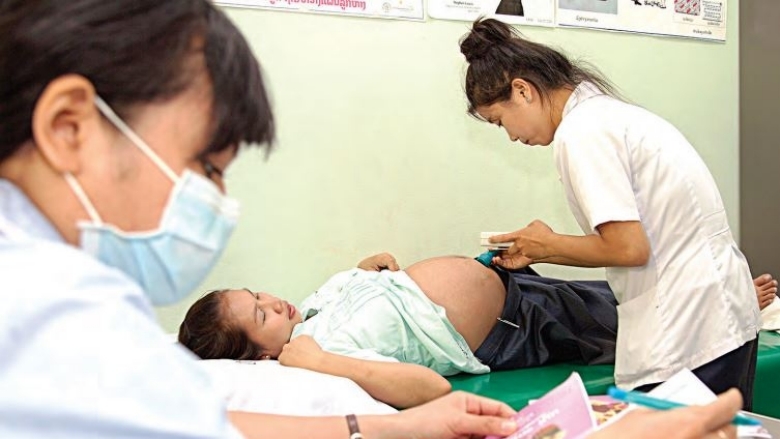This series of four policy notes provides a snapshot of health and nutrition in Lao PDR, with each note respectively focusing on government health spending, maternal and child expenditure, health care workers and the status of nutrition.
Government Expenditure on Health in Lao PDR
- Lao PDR has made notable progress in improving maternal and child health outcomes. However, by global standards, it still has some of the most lagging population health outcomes globally associated with low access to health services and worsening financial protection.
- Catastrophic health expenditure has worsened from 3.8% in 2007-2008 to 5% in 2012-2013.
- Lao PDR has low but increasing levels of government spending and is committed to increasing government health expenditure to 9% of total government expenditure by 2015.
- In moving towards universal health coverage (UHC), Lao PDR will need to decrease reliance on out of pocket-financed revenues from revolving drug funds, increase domestic government health financing (accompanied by a change in its composition and distribution), and strengthen pre-payment mechanisms.
Maternal and Child Out-of-Pocket Expenditure and Service Readiness in Lao PDR
- Maternal mortality has decreased from 1,600 per 100,000 births in 1990 to 220 per 100,000 births in 2013.
- However, only 38% of these births occurred in a health facility and only 56% and 39% of pregnant women received any antenatal and postnatal care. Income and geographic inequities in health service utilization further accentuate this problem.
- In order to achieve more, tackling low utilization of maternal health services and weak financial protection, especially among the poor, can help.
- The Government of Lao PDR has introduced a national free maternal and child health policy, which has the potential to reduce household expenditure on maternal health services substantially. However, this investment may be regressive due to the low utilization of health services among the poorer quintiles. Non-financial barriers, such as ethno-linguistic barriers, cultural barriers, poor education, physical access, need to be addressed, coupled with investments in the supply-side service readiness of facilities and staff, especially with regard to consumables such as essential drugs.
Lao PDR Health Center Workforce Survey
- At the national and regional-level, the number of critical health care workers was mal-distributed and low – just over half of WHO recommendations – although share of public spending on staff (within overall government health expenditure) was within global and regional norms.
- At the facility level, health centers were staffed typically with four health workers who were relatively under-utilized, with only six consultations per health worker per day on average. Underutilization may lead to continued low productivity and low clinical ability.
- Health care workers include medical assistants and nursing professionals with mid-level degrees and four years of work experience, who receive a mean income of 1,599,000 kip ($192).
- Almost half, or 44%, of health care workers never undergo in-service training. Where training was received, it was often mismatched with the type of health services being provided by the health worker.
- Although most health care workers were female (57%), 42% of health staff conducting deliveries were male, which may compound the already high cultural barriers in accessing maternity services.
- Poor service readiness (infrastructure, availability of medicines and equipment) and poor compensation were the main sources of dissatisfaction among health workers.
Nutrition in Lao PDR: Causes, Determinants and Bottlenecks
- The causes of undernutrition in Lao PDR are multi-sectoral ranging from factors that are determined before the child is born (mother’s stature, education, health, diet and age during pregnancy) to factors affecting the child after birth (sub-optimal infant and young child feeding, poor hygiene and sanitary environment).
- While food insecurity is widely assumed to be a major determinant of stunting in Lao PDR, World Bank analyses show that access to food is less of a concern, but rather the lack of dietary diversity (which is largely due to poor child feeding practices) is the main source of inadequate nutrient intake in children.
- Children born to young girls, to mothers with less than complete primary education and to mothers who are themselves stunted, are much more likely to be stunted. The likelihood of being stunted is 10% higher among children conceived by women below the age of 17.
- Poor knowledge about nutrition among health workers in rural areas is demonstrated in practice. 67% of health center staff have not received appropriate training on nutrition, and they tend not to recognize stunted children or offer appropriate recommendations about nutrition and growth promotion.
- A combination of demand-side and supply-side interventions are needed. On the demand-side, scaling up of social and behavior change communication directed at mothers, child caregivers, as well as influential family members (grandmothers, husbands), focusing on appropriate infant and young child feeding practices, improving sanitation and hygiene practices, and prevention of teenage pregnancy is needed.
- On the supply side, there is a need to improve health and nutrition services delivered by frontline health workers, particularly in strengthening the skills and confidence among health workers in providing nutrition and growth promotion counseling.
